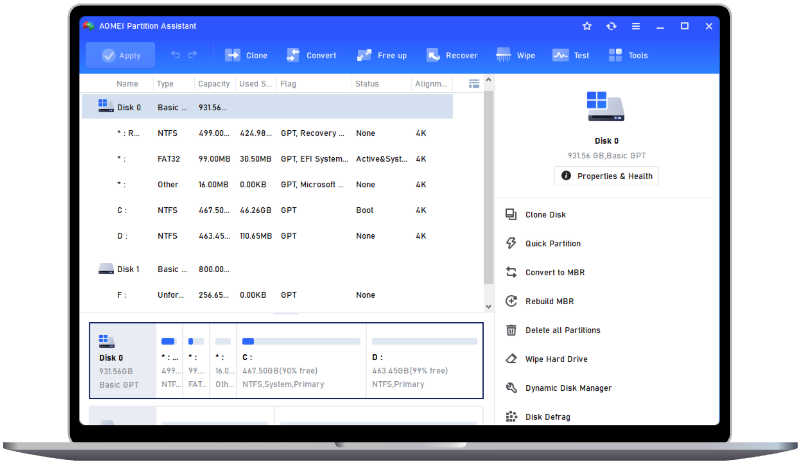[Fixed]: You May Not Shrink OEM, ESP, or Recovery Partitions
When managing disk partitions on your computer, you may encounter a warning stating, "You may not shrink OEM, ESP, or recovery partitions." In this post, we will explore the potential risks of resizing these partitions and provide step-by-step guidance on how to safely manage your partitions.
Shrinking partitions is a common task to free up space or optimize partition management. However, you might encounter an error message saying, "You may not shrink OEM, ESP, or recovery partitions" when attempting to resize certain partitions. Why does this happen, and how can you safely resize these partitions? Don’t worry! In this post, we’ll dive into the reasons behind this error and show you the safe steps to shrink your partitions without causing any issues. Keep reading to learn everything you need to know.
Overview of OEM, ESP, and Recovery Partitions
Before diving into why you can't shrink OEM, ESP, and recovery partitions, it’s important to understand what they are and why they’re crucial:
➤ OEM partition (Original Equipment Manufacturer partition) is a special partition created for system recovery, factory reset, or software installation. Generally, it is hidden, and you cannot access it directly through File Explorer, which helps prevent accidental modification.
➤ ESP (EFI System Partition) is an important partition for UEFI-based systems, which contains various boot files and other essential components for booting and managing the OS. Similarly, you may not see the ESP in File Explorer because it is hidden, but you can view it in Disk Management.
➤ The Recovery Partition is another hidden partition on your computer's hard drive that holds necessary files and tools to troubleshoot and repair the operating system when experiencing failures. With it, you can repair, reset, or reinstall the OS without needing external media like a DVD or USB drive.
Why You May Not Shrink OEM, ESP, or Recovery Partitions
As mentioned above, OEM, ESP, and recovery partitions are tightly integrated with your system's functionality. Freely resizing or modifying these partitions can lead to severe issues:
For OEM Partition:
Shrinking or altering the OEM partition may remove or corrupt the system recovery image, making it impossible to restore your computer to its original factory settings.
For ESP:
The ESP contains bootloader files that are essential for starting your system. Modifying or shrinking this partition improperly can prevent the firmware from properly reading, potentially leading to system crashes or boot failures.
For Recovery Partition:
Sometimes, resizing the recovery partition can disable built-in troubleshooting and repairing utilities, leaving you unable to recover or repair your system in case of failure.
How to Shrink OEM, ESP, and Recovery Partitions Safely?
If you still consider shrinking or extending OEM, ESP, or recovery partitions, we recommend using AOMEI Partition Assistant. It’s a powerful disk management and partition software compatible with Windows 11, 10, 8.1, 8, and 7, providing a safer and more flexible way to resize partitions. With just one click, you can easily adjust partition sizes to suit your needs.
Moreover, AOMEI Partition Assistant offers a variety of advanced features, including merging partitions, allocating free space, and moving partitions. This makes disk management simpler and more efficient, ensuring that you can resize your partitions without the risk of compromising system stability or data integrity.
Let’s use AOMEI Partition Assistant to shrink your OEM, ESP, and recovery partitions:
Step 1. Download and install AOMEI Partition Assistant on your device. Launch the software, right-click the partition you want to shrink, and select the 1-Click Adjust Space option.
Step 2. To shrink a partition without losing data, simply drag the dot at the beginning or end. For example, if you want to reduce the F: partition, drag the dot to the right. This action will shrink the F: partition and enlarge the D: partition simultaneously. Then, click OK to proceed.
Step 3. After setting the desired adjustments, preview the changes in the Pending Operations window. Then click Apply > Proceed to confirm and apply the changes.
Step 4. The process will start and you can check the progress. It might take time to finish the operation.
Step 5. Wait for the operation to be finished. Once complete, the partition sizes will have been adjusted accordingly.
Additional Tips for Resizing Partitions
Resizing partitions is not difficult, but it does come with potential risks. To ensure a smooth and safe process, follow these steps before altering your partition size:
💡 Back up Essential Data: It’s always a good idea to back up your essential data beforehand, especially when working with crucial partitions. If anything goes wrong during the process, you’ll have a reliable source to restore your files and avoid data loss.
💡 Check Free Space: Make sure the partition you want to shrink has enough free space to use. Windows will not allow you to shrink a partition if there isn't enough space to meet the requested size.
💡 Close All Running Processes: Make sure to close all applications and stop any processes using the drive you plan to shrink. This helps prevent interference and reduces the risk of errors.
To Sum Up
You may not shrink OEM, ESP, or recovery partitions because they are integral to your system's functionality. Modifying them improperly can lead to critical issues such as system instability or boot failures. For most users, it is recommended to leave these partitions alone to maintain system stability and ensure reliable recovery options.
If you still wish to resize these partitions, consider using professional tools like AOMEI Partition Assistant and following the provided steps to minimize risks and avoid potential errors.


